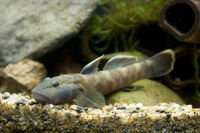Difference between revisions of "Rhinogobius candidianus"
From The Aquarium Wiki
(No difference)
|
Revision as of 20:11, 13 May 2014
Candidius Goby
Rhinogobius candidianus
95 Litres (25 US G.)
6-8 cm (2.4-3.1")
Freshwater
7.5 - 8.0
14 -25 °C (57.2-77°F)
6-16 °d
1:1 M:F
5-8 years
Family
Gobiidae
Contents
Additional names
- Candidius Goby
Additional scientific names
- Ctenogobius candidianus, Rhinogobius candidius, Rhinogobius taiwanus
Origin
|
|
This section requires expansion with: Location where this animal is found in the wild. |
Sexing
- Mature males are larger, more elongated and colourful than females. Females have more rounded fins than males and develop dark abdomens when in breeding condition.
Tank compatibility
- These are generally peaceful fish but will be territorial towards conspecifics. For a pair you need a minimum of a 61cm (24") long tank. Will work with other current-loving sub-tropical fish such as White Cloud Mountain Minnows.
Diet
- Should accept meaty foods such as bloodworm and brine shrimp as well as catfish pellets/wafers.
Feeding regime
- Feed once or twice a day.
Environment Specifics
- A sub-tropical species that needs highly oxygenated water. Does well in a biotope set up with a strong filter and sand/gravel mix substrate. They love a strong current. They will suffer at higher tropical temperatures, between 14-20°C (57.2-68°F) is best, for breeding it should be closer to 24-25°C (75.2-77°F) .
Behaviour
- A peaceful bottom dwelling fish. Will be territorial towards other Gobies however. Will rearrange the substrate, digging in the sand and gravel. Any décor should be secure for this reason as they will redecorate!
Identification
- An elongate fish easily misidentified with other Rhinogobius species including Rhinogobius gigas. This fish is typical in Goby shape with a large head and eyes set on the top of the head. It has three dorsal fins, the first is small and only raised to display, the main dorsal is pointed and dark in colour and the broad third dorsal is red in colour and edged in yellow, the caudal fin is the same in colour. The body is cream-grey in colour with the scales edged in orange. The head has horizontal orange stripes, one from the nose to the eye and another around the gill plate to the mouth. These bands extend behind the head and blend into the body colour.
Pictures
External links
- Fishbase (Mirrors: Error creating thumbnail: Unable to save thumbnail to destination)
